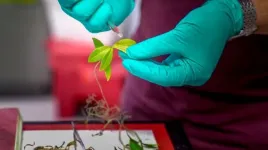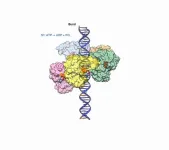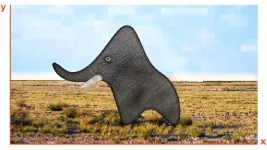(Press-News.org) ITHACA, N.Y. - Water regulation in leaves is vital to a plant's health, affecting its growth and yield, disease susceptibility and drought resistance.
A breakthrough technology developed by Cornell University researchers uses nanoscale sensors and fiber optics to measure water status just inside a leaf's surface, where water in plants is most actively managed.
The engineering feat provides a minimally invasive research tool that will greatly advance the understanding of basic plant biology, and opens the door for breeding more drought-resistant crops. The technology could eventually be adapted for use as an agronomic tool for measuring water status in crops in real time.
The study in maize plants, "A Minimally Disruptive Method for Measuring Water Potential In-Planta Using Hydrogel Nanoreporters," published June 1 in the Proceedings of the National Academy of Sciences.
"One of the goals is to have tools that allow internal biology to be expressed out into the world in a way that can be captured and digitized," said senior author Abraham Stroock, professor in the Smith School of Chemical and Biomolecular Engineering in the College of Engineering.
"Current techniques for measurements of water potential require destructive sampling of leaves or disrupting leaf function," said co-first author Piyush Jain, a doctoral student in mechanical engineering. The new method, he said, "provides minimally disruptive and spatially and temporally resolved measurements of water potential in leaves of intact plants."
Outside of leaves' transport tissues, called xylem (the veins), lies an interior zone called the mesophyll, where most of the plant's photosynthesis and water stress occurs. Biologists suspect that signals are sent from here to the rest of the plant for managing water. Also, at the surfaces of leaves and stems, pores called stomata open and close to control the rate of exchange of gasses, mostly water vapor and carbon dioxide.
The new technology works in this microscopic zone.
"We are now sensing water right at that terminal place," Stroock said. "We've shown that by getting such a localized measurement, we can dissect the dynamics of water in the tissues" in minimally invasive ways, he said.
The technique involves injecting a nanoparticles formed of a soft synthetic hydrogel, called AquaDust, for measuring a leaf's water potential. The hydrogel, which occupies the interstitial spaces between cells in the mesophyll, is water-absorbent, swelling and shrinking based on water availability in the leaf.
The AquaDust contains dyes whose interactions allow it to fluoresce at different wavelengths depending on how close the dye molecules are to each other. By using fiber optics, the researchers can shine a light and get a spectrum back, which provides a measurement of water potential inside the leaf.
In the study, the researchers injected the AquaDust in multiple places along meters-long maize leaves and then measured the water gradients both along the length of the leaves and through the mesophyll. These measurements allowed them to develop a model of the tissue response to water stress and accurately predict the dynamics observed in the field.
This technology may have commercial applications for crop research, production agriculture, and manufacturing industries, but for now the researchers' focus is on the invaluable measurements of very local physiology of water management in plants. As a research tool, it allows plant biologists to better understand extremes of water stress, which could lead to breeding more water-efficient crops.
INFORMATION:
Michael Gore, professor of molecular breeding and genetics in the Plant Breeding and Genetics Section of the School of Integrative Plant Science in the College of Agriculture and Life Sciences, is a co-author. Weizhen Liu, a former post-doctoral researcher in the Gore lab and current associate professor at Wuhan University, is co-first author.
The study was funded by the U.S. Department of Agriculture's National Institute of Food and Agriculture, the U.S. Air Force Office of Scientific Research, and the Rural Development Administration of the Republic of Korea.
This work was performed in part at the Cornell NanoScale Science and Technology Facility, a member of the National Nanotechnology Coordinated Infrastructure, which is funded by the National Science Foundation.
Sickle Cell Disease (SCD) is a genetically inherited group of red blood cell disorders. END ...
DURHAM, N.C. - A group of researchers have discovered the detailed inner workings of the molecular motor that packages genetic material into double-stranded DNA viruses. The advance provides insight into a critical step in the reproduction cycle of viruses such as pox- herpes- and adeno-viruses. It could also give inspiration to researchers creating microscopic machines based on naturally occurring biomotors.
The research was conducted by scientists from Duke University, the University of Minnesota, the University of Massachusetts and the University of Texas Medical Branch (UTMB). The results appear online in a trilogy of papers published in Science Advances, ...
WHO: JoAnn Manson, MD, DrPH, Physician and Epidemiologist, Division of Preventive Medicine, Brigham and Women's Hospital; co-author of a new Perspective piece published in The New England Journal of Medicine (pdf attached)
WHAT: Less than 50 years ago, a U.S. Supreme Court decision paved the way for women's use of contraception irrespective of marital status, and a year later, in 1973, the Court ruled in Roe v. Wade that women have a right to legalized abortion. In recent decades, clinical researchers and policymakers alike have made important strides ...
You would not be surprised to see an elephant in the savanna or a plate in your kitchen. Based on your prior experiences and knowledge, you know that is where elephants and plates are often to be found. If you saw a mysterious object in your kitchen, how would you figure out what it was? You would rely on your expectations or prior knowledge. Should a computer approach the problem in the same way? The answer may surprise you. Cold Spring Harbor Laboratory Professor Partha Mitra described how he views problems like these in a "Perspective" in Nature Machine Intelligence. He hopes his insights will help researchers teach computers how to analyze complex systems more effectively.
Mitra thinks it helps to understand the nature of knowledge. Mathematically speaking, many data scientists ...
The surface of the sun churns with energy and frequently ejects masses of highly-magnetized plasma towards Earth. Sometimes these ejections are strong enough to crash through the magnetosphere -- the natural magnetic shield that protects the Earth -- damaging satellites or electrical grids. Such space weather events can be catastrophic.
Astronomers have studied the sun's activity for centuries with greater and greater understanding. Today, computers are central to the quest to understand the sun's behavior and its role in space weather events.
The ...
MADISON, Wis. -- For birds and other wildlife, winter is a time of resource scarcity. Extreme winter weather events such as a polar vortex can push some species to the edge of survival. Yet winter tends to get short shrift in climate change research, according to UW-Madison forest and wildlife ecology Professor Ben Zuckerberg.
"When we think about the impact of climate change, winter tends to be overlooked as a time of year that could have significant ecological and biological implications," says Zuckerberg. "It makes me, and my colleagues, think quite deeply about the impacts of these extreme events during this time when species are particularly vulnerable."
Zuckerberg, ...
Using a piece of magnet, researchers have designed a simple system that can control the movement of a small puddle of water, even when it's upside down. The new liquid manipulation strategy, described in the journal Cell Reports Physical Science on June 3, can have a wide range of applications including cleaning hard-to-reach environments or delivering small objects.
Previous attempts to control the movement of fluids often relied on special platforms. For example, on a surface that has one section more hydrophobic than another, water will spontaneously ...
Anyone that's ever interacted with a dog knows that they often have an amazing capacity to interact with people. Now researchers reporting in the journal Current Biology on June 3 have found that this ability is present in dogs from a very young age and doesn't require much, if any, prior experience or training. But, some of them start off better at it than others based on their genetics.
"We show that puppies will reciprocate human social gaze and successfully use information given by a human in a social context from a very young age and prior to extensive experience with humans," said Emily E. Bray of the University of Arizona, Tucson. "For example, even before puppies have left their littermates to live ...
Whales are largely protected from direct catch, but many populations' numbers still remain far below what they once were. A study published in the journal Current Biology on June 3 suggests that, in addition to smaller population sizes, those whales that survive are struggling. As evidence, they find that right whales living in the North Atlantic today are significantly shorter than those born 30 to 40 years ago.
"On average, a whale born today is expected to reach a total length about a meter shorter than a whale born in 1980," said Joshua Stewart of the National Oceanic and Atmospheric Administration (NOAA) in La Jolla, CA. That represents an average decline in length of about 7%. "But that's just the average--there are also some extreme cases where young whales are several ...
Patients who, perhaps unbeknownst to their health care providers, are in need of genetic testing for rare undiagnosed diseases can be identified en masse based on routine information in electronic health records (EHRs), a research team reported today in the journal Nature Medicine.
Findings from the Vanderbilt University Medical Center study suggest that, among the patients of any sizeable health care system, there are hundreds or thousands with undiagnosed rare diseases of the sort where a genetic test could lead to a diagnosis.
"Patients with rare genetic diseases often face ...







